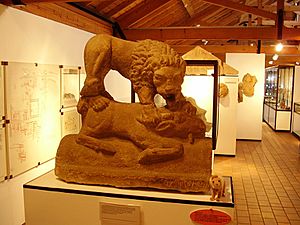Corbridge Lion facts for kids
The Corbridge Lion is an amazing ancient Roman stone sculpture found in Corbridge, Northumberland, England. It shows a strong male lion standing over another animal, possibly a deer. This sculpture is made of sandstone and is quite large, measuring about 0.95 meters long, 0.36 meters wide, and 0.87 meters high.
Experts believe it was first used as a decoration for a tomb (a burial place). It likely represented the idea of life overcoming death. Later, it was cleverly reused as a fountain! A water pipe was passed right through the lion's mouth.
Contents
Discovering the Ancient Lion
The Corbridge Lion was found in 1907 during an archaeological excavation (a dig to uncover old things). It was discovered in a water tank at the Roman site in Corbridge. The dig was led by a famous archaeologist named Leonard Woolley.
The area where it was found was part of a large building. This building had cool features like tiled floors, special heating systems called hypocausts (which heated floors and walls), and painted walls. Some think this building might have been a mansio, which was like a rest stop or hotel for travelers in Roman times. The lion is thought to be from the 2nd or 3rd centuries AD, meaning it's around 1,800 years old!
A Funny Discovery Story
Leonard Woolley wrote about finding the lion in his book, Spadework. He said that he was away collecting the workers' wages when they found it. When he came back, the worker who dug it up told him, "when I first saw that there lion he had a blooming orange in 'is mouth!" This was just a funny way of saying the lion's mouth was open and empty when he first saw it.
Other Lions in Corbridge
The Corbridge Lion isn't the only one found in the area! At least four other stone lions have been discovered around Corbridge. Two of them were found near a 2nd-century mausoleum (a large, fancy tomb) in a cemetery west of the Roman town. Another was found built into a wall in the village. There was even one more that was in a private museum in the early 1800s, but it's now lost.
Where to See the Corbridge Lion Today
If you want to see the Corbridge Lion, you can! It is now on display at the Corbridge Roman site museum. This museum is managed by English Heritage, which looks after many historic places in England. There was even a hotel nearby called The Lion of Corbridge Hotel, named after this famous sculpture, but it closed in 2003.


